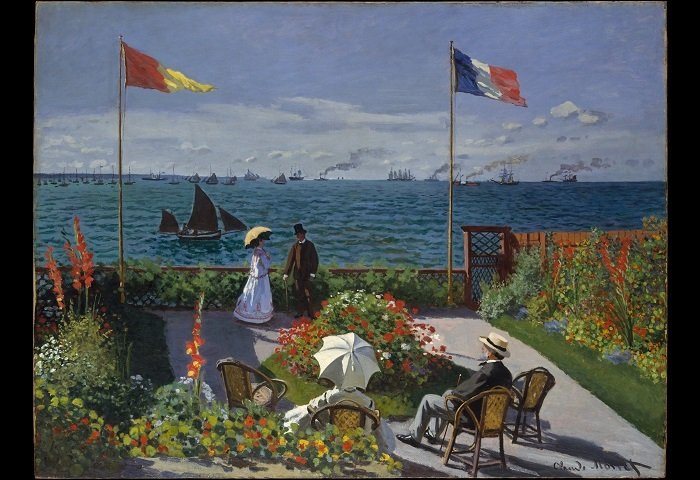
10 Aug Claude Monet: Father of Impressionist
Oscar-Claude Monet was a founder of the French impressionist paintings. The term “Impressionism” actually came from the title of his painting “Impression, soleil levant” which meant Impression, Sunrise. Monet adopted a method of painting the same scene many times to capture the changing of light and seasons mostly on French countryside. As his birth time is not available, his moon chart is used as a secondary assessment.
Move to Le Havre, Normandy
In 1845, Transiting Jupiter and Ketu were in Monet’s 4th house of home, aspected by Transiting Saturn and Mars. It separated him from his home and his whole family moved to Le Havre in Normandy.
The Artist Monet
Monet has 5 planets in the 5th house of art and creativity, Sun, Jupiter, Mercury, Saturn, Venus. Sun and Venus rule the main houses of money, Jupiter rules the 9th house of fortune and Mars rules the 5th house of creativity aspecting the 5th house. There are multiple Raja yogas (combinations of power and luck) and dhana yogas (combinations of wealth) in the 5th house. Moreover, the moon nodes of Rahu and Ketu all disposited into Sun and Saturn in the 5th house as well. His Mars ruling the 5th house of art and 10th house of career is his yogakaraka planet, a planet of power and luck sitting in the 2nd house of wealth. The mutual aspects of Mars in 2nd house and Saturn in 5th house means that he will always rely on his artistic talents to make money.
His whole life is all concentrated on his artistic efforts. His father wanted him to go into the family’s ship-chandling and grocery business but Monet wanted to become an artist. Moon is strong in the Cancer sign in his 1st house. His mother was critical to Monet’s life development. His mother was a singer and supported Monet’s career in art.
The difficult planets Jupiter, Saturn, and Mercury ruling his 6th house, 8th house, and 12th house respectively all sits in the 5th house of his mind. Despite being a baptized Catholic, Monet later became an atheist.
Beginning of Impressionism
In 1872 in Ketu/Ketu period, Transiting Ketu was in his 5th house of creative works aspected by Jupiter. He was retreating into his world and triggered his intuition for the beginning of Impressionism. The painting “Impression, soleil levant” (Impression, Sunrise) was born in 1872, depicting a Le Havre port landscape.
Subsequently in 1874 April to May still in his Ketu period, Transiting Rahu was in his 10th house of fame, aspected by both Transiting Jupiter and Saturn. The first Impressionist exhibition was held in 1874 at 35 boulevard des Capucines, Paris. The purpose of the exhibition was to give artists the opportunity to show their work without restrictions from the Salon de Paris. He also displayed his other paintings of The Luncheon (1868) and Boulevard des Capucines. 165 works were displayed in this groundbreaking exhibition. Monet asking for 1000 francs for the Impression: Sunrise was not sold at that time.
Death of Camille Monet
On September 5 1879 in Venus/Venus period, this is a period deeply signifying the wife of Claude Monet, Camille Monet. Transiting Ketu as significator of losses is at the 1st house aspecting the Natal Saturn ruling the 7th house of spouse and Natal Venus as significator of wife in the 5th house. Transiting Mars and Pluto were also aspecting Natal Saturn and Venus amplifying the malignance. Transiting Saturn representing the spouse was in the 9th house ruled by Jupiter and Transiting Jupiter was in the 8th house of death ruled by Saturn. This brings the death to his spouse.
Earlier in 1876, Camille Monet became ill with tuberculosis. In 1878, Camille Monet was diagnosed with uterine cancer and she later died at the age of 32. This propelled Claude Monet to make a study in oils of his dead wife and this analysis of colours was both the joy and torment of his life. The painting of his dead wife with a blizzard of white, grey, purplish paint expresses the intensity of his blizzard of loss.
Death of Claude Monet
On December 5 1926 in Rahu/Jupiter period, Transiting Rahu was in the 12th house of endings and Transiting Jupiter was in the 7th maraka house of death. Natal Mars was in the 2nd maraka house. Transiting Mars was aspecting the 5th house by it’s 8th death aspect and Transiting Saturn, Mercury, Sun, Moon, Venus were all in the 5th house. Transiting Sun and Saturn rules the 2nd and 7th maraka houses of death and they are transiting back into the natal positions.
Monet died of lung cancer on this day at the age of 86. He is buried in the Giverny church cemetery.
Monet’s House and Garden
In 1883 May in Venus period, Venus rules the 4th house of home. Transiting Rahu was in the 4th house of home aspecting Natal Rahu in the 8th house of changes and Transiting Jupiter in the 12th house of endings. Transiting Venus ruling the 4th house of home was exalted in the 9th house of fortune together with Transiting Mars which was aspecting the 4th house of home. In 1890 Venus/Jupiter period, Venus rules 4th house of home conjunct Jupiter and Jupiter was aspecting the Moon in Cancer which is the original house of the home.
Monet rented house and garden in Giverny. The house was situated near the main road between Vernon and Gasny in Giverny. The family worked and built up the gardens and Monet’s fortunes began to raise. Eventually in 1890, Monet became prosperous enough to buy the house and he built a greenhouse and a second studio with vast landscaping project which included lily ponds that became some of his best-known works. The house and garden were entrusted by his son Michel to the French Academy of Fine Arts in 1966. The house and the garden were among the major attractions in Giverny.
Claude Monet, Impression on the World
Monet has contributed to the Impressionism movement and became the founding father of impressionist paintings. Inspired by the works of Camille Pissarro and Edouard Manet, he and his painting gave the lasting name of Impressionism.
You too can leave an imprint on the surface of this earth no matter how small the difference you think you can make. It’s how you do it that gets imprinted in the minds of many that you meet.
If you want to know what kind of impressions that you are meant to make in this world, please check out our Astrology Services below.
Personal Astrology Consultation
Online Astrology Consultation
To find out where your Ascendant sign and Moon sign are in your birth chart in sidereal calendar, please check out our Astrology Reports below.
Full Astrology Report
Below are some samples of Monet’s works for your pleasure.
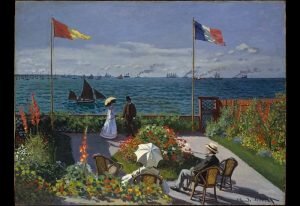
Claude Monet – Garden at Sainte Adresse
Garden at Sainte-Adresse 1867, Claude Monet (Featured Painting on the top)
Monet spent the summer of 1867 with his family at Sainte-Adresse, a seaside resort near Le Havre. It was there that he painted this buoyant, sunlit scene of contemporary leisure, enlisting his father (shown seated in a panama hat) and other relatives as models. By adopting an elevated viewpoint and painting the terrace, sea, and sky as three distinct bands of high-keyed color, Monet emphasized the flat surface of the canvas. His approach—daring for its time—reflects his admiration for Japanese prints. Twelve years after it was made, Monet exhibited the picture at the fourth Impressionist exhibition of 1879 as Jardin à Sainte-Adresse.

Claude Monet – La Grenouillere
La Grenouillère 1869, Claude Monet
During the summer of 1869, Monet and Renoir set up their easels at La Grenouillère, a boating and bathing resort on the Seine River, not far from Paris. Monet noted on September 25, “I do have a dream, a painting, the baths of La Grenouillère, for which I have made some bad sketches, but it is only a dream. Renoir, who has just spent two months here, also wants to do this painting.” Among their various depictions of the subject, this composition closely resembles one by Renoir in the National Museum, Stockholm.
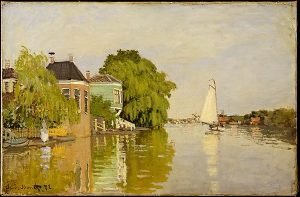
Claude Monet – Houses on the Achterzaan
Houses on the Achterzaan 1871, Claude Monet
On the advice of the French painter Charles-François Daubigny, Claude Monet traveled to the Netherlands in 1871, where he painted this landscape of limpid waters and azure skies along the Achterzaan River in Zaandam. Writing to fellow Impressionist Camille Pissarro, Monet noted the pleasures of painting the picturesque Dutch landscape: “This is a superb place for painting. There are the most amusing things everywhere: hundreds of windmills and enchanting boats, extremely friendly Dutchmen…” Using a limited palette of varying shades of green, Monet has captured the hazy atmosphere and light-dappled water of this picturesque Dutch port. Monet’s Dutch landscapes were widely admired by other contemporary artists, especially Daubigny, whose own studies of light and water share an affinity.
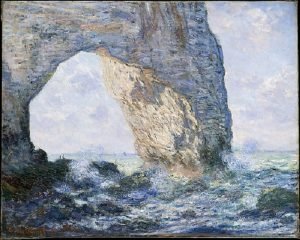
Claude Monet – The Manneporte Etretat
The Manneporte (Étretat) 1883, Claude Monet
Monet spent most of February 1883 at Étretat, a fishing village and resort on the Normandy coast. He painted twenty views of the beach and the three extraordinary rock formations in the area: the Porte d’Aval, the Porte d’Amont, and the Manneporte. The sunlight that strikes the Manneporte has a dematerializing effect that permitted the artist to interpret the cliff almost exclusively in terms of color and luminosity. Most nineteenth century visitors were attracted to the rock as a natural wonder. Monet instead concentrated on his own changing perception of it at different times of day.

Claude Monet – The Four Trees
The Four Trees 1891, Claude Monet
During summer and fall 1891 Monet painted a series of views of poplars along the Epte River, at Giverny. Completion of the series was temporarily threatened when the village of Limetz, across the Epte from Giverny, decided to sell the trees at auction. Monet paid a local lumber merchant to ensure that the trees remained standing until he finished his work. He painted some of the pictures from the riverbank, and others, such as this one, from a boat specially outfitted with grooves to hold multiple canvases. Like the Haystacks, the Poplars were first exhibited as a series. Fifteen were shown in Paris in 1892.
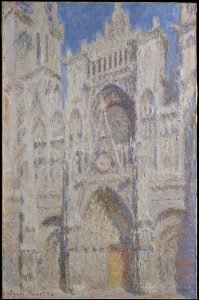
Claude Monet – Rouen Cathedral The Portal Sunlight
Rouen Cathedral: The Portal (Sunlight) 1894, Claude Monet
Monet painted more than thirty views of Rouen Cathedral in 1892–93. Moving from one canvas to another as each day progressed, he painted the facade with highly textured brushstrokes that convey the aspect of sculpted stone and make the atmosphere and light palpable. Monet later finished the works in his studio at Giverny, carefully adjusting the pictures both independently and in relation to each other. Hence, most are signed and dated 1894, as is this example. In 1895, Monet exhibited twenty of his cathedral pictures at Galerie Durand-Ruel in Paris. This one was titled Le Portail (Soleil), or The Portal (Sunlight).
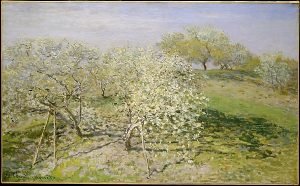
Claude Monet – Spring (Fruit Trees in Bloom)
Spring (Fruit Trees in Bloom) 1873, Claude Monet
Monet made this work in the vicinity of his home in Argenteuil, a village on the Seine northwest of Paris that was a favorite gathering place of the Impressionists. Although the scene has previously been called Plum Blossoms and Apples Trees in Bloom, the type of tree cannot be determined from the flurry of white buds evoked by the artist. The pastel shades of spring and the clear light inspired him to represent nature almost purely in terms of color. This was the first painting by Monet to enter the Museum’s collection, via bequest in 1926.
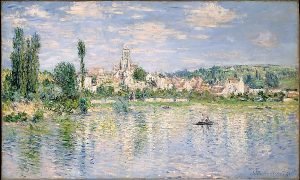
Claude Monet – Vetheuil in Summer
Vétheuil in Summer 1880, Claude Monet
In this view of Vétheuil, seen from the opposite bank of the Seine, the flicker of individual brushstrokes reflects Monet’s concern with recording sensations of color and light as accurately as possible. Ironically, this practice resulted in paintings of an increasingly abstract nature. Indeed, the imagery nearly dissolves in the myriad touches of paint.

Claude Monet – The Valley of the Nervia
The Valley of the Nervia 1884, Claude Monet
Monet spent three months on the Italian Riviera in early 1884. He wrote a friend, “everything is superb and I want to paint it all … there are many experiments to make. This landscape is a new experience for me.” Installing himself in the coastal town of Bordighera, Monet explored the scenic terrain. Here, he employed light, bright tones to depict the snowy Maritime Alps along the border with France. Nestled among the hills is the village of Camporosso, on the banks of the Nervia, not far from the river’s outlet in the Mediterranean Sea.
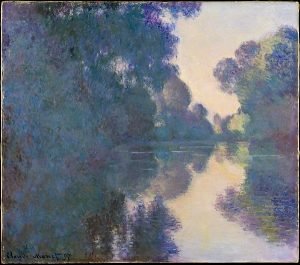
Claude Monet – Morning on the Seine near Giverny
Morning on the Seine near Giverny 1897, Claude Monet
Begun in 1896, Monet’s Mornings on the Seine series was not completed until 1897 because of inclement weather. Having patiently scouted out views along the river, Monet then painted the pictures from a boat that he had converted into a floating studio. For an extended period he rose by dawn in order to paint the changing effects of light as the sun came up. He then lined up the canvases on easels in his studio to complete them together as a series. Fifteen were shown at the Galerie Georges Petit in 1898.
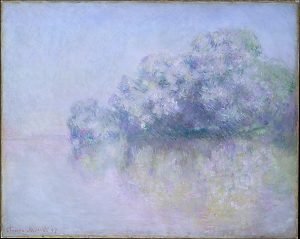
Claude Monet – Ile aux Orties near Vernon
Île aux Orties near Vernon 1897, Claude Monet
The Île aux Orties (Island of Nettles) is situated not far from Monet’s home at Giverny, near the confluence of the Epte and Seine. Monet owned the property, which is now joined to the riverbank, and used it to moor his boats. He painted four versions of this composition, all signed and dated 1897. The setting and the misty, luminous atmosphere are similar to that of Morning on the Seine near Giverny (56.135.4), one of a series of views which Monet completed that year along the same stretch of water.

Claude Monet – Water Lilies
Water Lilies 1919, Claude Monet
This work is one of four pictures of water lilies that, quite exceptionally, Monet finished, signed, and sold in 1919. Much of his late work was not finished, and few paintings were released for sale. In a letter he reported that he was not yet pleased with the paintings, but that he was working on them “with passion.”
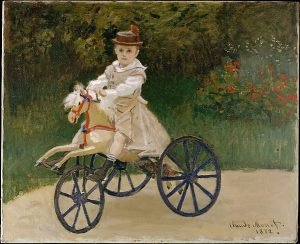
Claude Monet – Jean Monet on His Hobby Horse
Jean Monet (1867–1913) on His Hobby Horse 1872, Claude Monet
Monet painted this picture of his elder son, Jean, in the summer of 1872, not long after the artist and his family returned to France from self-imposed exile during the Franco-Prussian War. Thanks to the efforts of the dealer Paul Durand-Ruel, the painter’s finances had begun to improve, enabling the once-impoverished Monets to rent a house in Argenteuil, an agreeable suburb northwest of Paris. For this portrait, Monet posed the five-year-old Jean in the garden of their new home. Monet never exhibited the painting but kept it throughout his life.
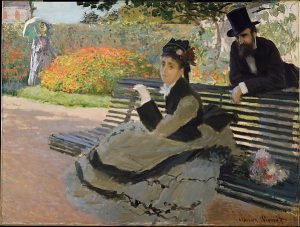
Claude Monet – Camille Monet on a Garden Bench
Camille Monet (1847–1879) on a Garden Bench 1873, Claude Monet
Monet’s wife, Camille Doncieux, is as easily identifiable here as the mounds of geraniums in the garden of the couple’s house at Argenteuil. The same is true of her smart ensemble: the velvet and damask outfit closely resembles the look for spring 1873, as advertised in the March issue of the fashion periodical La Mode Illustré. Less clear is the nature of this enigmatic scene. Painted the year Camille’s father died, she telegraphs sadness while holding a note in her gloved hand. The tophatted gentleman, later identified as a neighbor, has perhaps called to offer his condolences and a consoling bouquet.
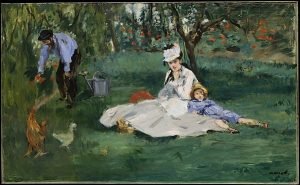
Edouard Manet – The Monet Family in Their Garden at Argenteuil
Family in Their Garden at Argenteuil 1874, Édouard Manet
Now this is not a painting by Monet but by Édouard Manet on Monet’s family.
In July and August 1874 Manet vacationed at his family’s house in Gennevilliers, just across the Seine from Monet at Argenteuil. The two painters saw each other often that summer, and on a number of occasions they were joined by Renoir. While Manet was painting this picture of Monet with his wife Camille and their son Jean, Monet painted Manet at his easel (location unknown). Renoir, who arrived just as Manet was beginning to work, borrowed paint, brushes, and canvas, positioned himself next to Manet, and painted Madame Monet and Her Son (National Gallery of Art, Washington, D.C.).

Claude Monet Moon Chart 01

Claude Monet Moon Chart 02





Gauri Eleanora Trainor
Posted at 04:28h, 11 AugustThis is a masterpiece in both the Chart Interpretation. and a tribute to the genuis, impeccable. and satvick work of Monet. Thank you adding his glorious masterpieces …it added depth and understanding.